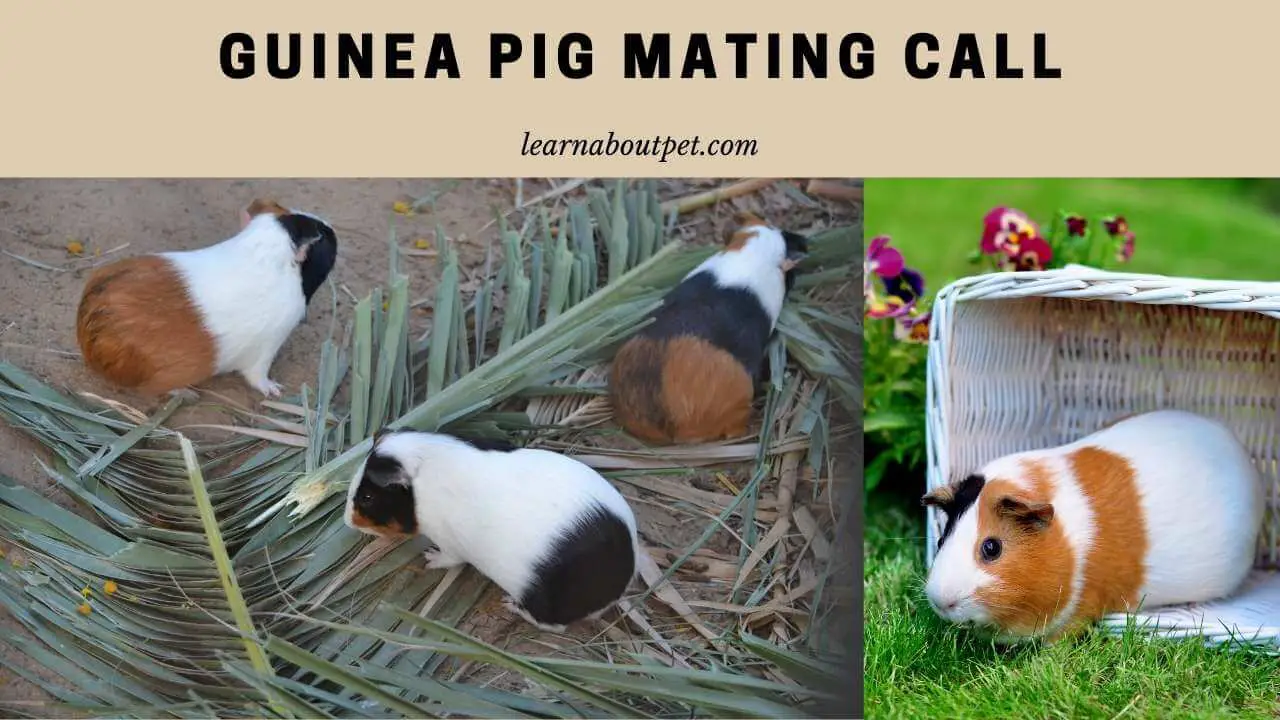Guinea pigs are known for their loud, high-pitched trill. But did you know that they also communicate their reproductive readiness with a special call?
The guinea pig mating call can be squeaked by both female and male guinea pig and the pitch and frequency varies based on gender. It’s a distinctive wheeking sound that they make from the end of their throat.
Learn more about guinea pig mating calls, why your guinea pig has them and what you can do to stop them here.

Mating Behavior in Guinea Pigs
There are several reasons why guinea pigs make these loud noises. One is during mating itself, which involves lots of courting behavior between two guinea pigs, or boars (male) and sows (female). The noise may be part of the process of getting the sow to stand still for breeding. Other noises include grunts made by either one or both of the guinea pigs.
Boars sometimes make a noise referred to as “wheeking” when they are excited, usually because you’re about to feed them. The sound is similar between boars and sows; it has been described as almost like a bird-like warble. Sometimes the male will also squeak to the sow if she moves away from him if he is courting her.
Another reason for the “wheek” noise is because it makes boars and sows feel safe and comfortable around you, as if to say they trust you (even though most of the time they don’t). The squeaking may also be a way to show excitement and anticipation to be fed, as mentioned before.
The behavior is sometimes seen among groups of boars, or bachelor groups. Since these animals are herd animals and like to stick together in small groups, it may be a way for them to announce to the rest of the group that he is interested in mating. They also do this so they can find one another in the wild if they get separated, as it is a loud noise that can be heard from a long distance away.
Do Guinea Pigs Call Each Other?
Some people have said that they’ve heard their guinea pigs calling to each other from across the room, but there is no evidence of this. It has been theorized that these noises only come from one guinea pig at a time and are not really a form of communication between two or more animals.
Pitch and Frequency of Sound
Sows make the most noises, and they do it more often than boars. The sound can be very loud; some people say it is one of the most annoying sounds heard from a guinea pig, along with squeaks made during feeding time or when agitated.
The pitch varies with the type of noise your guinea pig makes. The squeaks made during feeding and the wheek noise (sometimes called chirping) is at a higher pitch. The mating call is lower, similar to the sound of a whistle or an elephant’s trumpet.
Why Is My Guinea Pig Wheeking?
It’s not always easy to tell the difference between a male and female guinea pig, or if you have two males together, but there are some ways to tell. One way is to look at an older photo of the guinea pig when it was younger, and compare the size and shape of his body.
Another way is by looking for any sign of a “junk” on the guinea pig. The more junk between their hind legs, the more likely that they are a male guinea pig. Another sign is by looking at the shape of their face; boars tend to have a leaner and more elongated head than sows.
If you believe there are two males in a group together, watching them interact with one another can help you figure out which one is the dominant male, as the submissive male generally runs away from the other. The dominant male is usually the one making the mating call noises, as well.
If you are unable to figure out if your guinea pig is a boar or sow by any of these methods, there’s no need to worry! The older they get, you will be able to tell by their genitalia and behavior which gender it is.
Wheeking is sometimes more noticeable among boars than sows because they are the ones who initiate the mating process. It can be frustrating to hear, especially if you’re trying to keep the guinea pigs separated for whatever reason, but there’s no need for concern or worry! Just like how it is in people, some guinea pigs have a higher or lower pitch to their voices, and you may be more sensitive to certain pitches than others.
If your guinea pig is wheeking a lot, there may also be a medical problem at hand. Make sure it is eating well and stays hydrated to make sure that they are getting the nutrients they need. If not, it may be a sign that there is something wrong that should be checked out by your local veterinarian.
When guinea pigs get older, they tend to wheek less than when they were younger, and it’s usually not as loud or long of a vocalization. You may notice some wheeking during play or cuddling time with you; this means that they are comfortable enough to do this with you and trust you. It can be like an endearing conversation between two guinea pigs!
Wheeking is also made by one guinea pig if it’s separated from the rest of its group; this can mean that it misses them or just wants to come back so they can play together.

What Is The Mating Season For Guinea Pigs?
The mating season is Spring Season. Mating may happen from mid-February to late May. This can vary with environmental factors; for example, it usually happens earlier if the weather is warmer and later in colder seasons.
Guinea Pig Mating Signs to Look Out For
Once a female is in heat, the male will approach her and begin sniffing. As he does this, she’ll either run away or rear up on her back legs to signal that she’s interested. Guinea pigs may also make squeaking noises during mating. The female usually lies down immediately after mating; the male may stay with her, but he may also run away after mating.
This can be a little disconcerting for owners, but it does not cause any harm to the female.
Mating season runs from February to May in most areas, with gestation lasting 56–72 days. It is possible for guinea pigs to conceive only a few hours after mating; however, it is more likely that they will need at least a day between matings for the sperm to build up and impregnate the female.
Females can become pregnant as early as four months of age and breed year-round, but mature boars (males greater than four months of age) are usually unable to breed successfully with females until they reach sexual maturity at about five months.
How Long Do Guinea Pigs Stay In Heat?
The female guinea pig is in heat for about a day, but mating may stay successful for several days.
Pregnancy usually lasts between 60 and 72 days, but it can be as short as 56 or as long as 77 days. This is one of the most common signs that a female guinea pig may be pregnant.
How Can I Tell If My Guinea Pig Is Pregnant?
Watch for weight gain, softening of the nipples, and mammary development. If your guinea pig is already pregnant, watch for weight gain, enlargement of the abdomen, and decreased interest in food.
What Symptoms Will My Guinea Pig Have While Pregnant?
Guinea pigs should begin to show changes in their appearance when they are about one month into pregnancy; these can include weight gain, mammary development, and increased water intake. The nipples will also darken in color when the guinea pig is about two to three months into pregnancy.
As gestation progresses, you may notice that your guinea pig stops eating; this is because the mass in its abdomen is compressing the intestines, making it difficult for the guinea pig to eat comfortably. If she continues eating, she may throw up or have diarrhea, so it is important that you help your guinea pig to stop eating if she refuses food for more than one day.
You will also notice an enlargement of the abdomen because of how the uterus fills with fetuses and amniotic fluid.
What Happens To My Pregnant Guinea Pig’s Uterus After She Gives Birth?
The uterine horn that is not occupied by the fetus becomes filled with blood, forming the red bag of waters. When this ruptures at birth, it forms a pinkish fluid. The placenta also begins to form in the third month of gestation and is complete by the seventh month.
How Will I Know If My Guinea Pig Has Given Birth?
You will notice that she has pulled out all of her hair under her tail, which can cause bald patches. You may also see that she’s licking her genital area more than usual; this is because she’s cleaning her vulva. Your guinea pig may even have trouble urinating, so she may repeatedly sit in the litter box without going.
Due to the risk of infection during birth, you may notice that your guinea pig has a higher temperature than normal; this is known as a post-partum fever and is caused by increased stress levels. If your guinea pig does not eat within 12 hours after giving birth, she may show signs of a post-partum depression, which can include lethargy and loss of appetite.
Can A Guinea Pig Get Pregnant With Two Or More Males?
Yes, but it doesn’t happen very often. It’s even more uncommon if the male is younger than four months of age.
The female guinea pig has a vaginal corona, which makes it difficult for the sperm to penetrate easily. In order for fertilization to occur, two or more males will have to mate with her within a very short time frame. If this doesn’t happen, she will become pregnant with only one male’s sperm.
Final Verdict – Guinea Pig Mating Call
The male guinea pigs call is higher in pitch, but it makes a whiny sound. The female’s mating call is lower in pitch and louder.
Mating is a great way to ensure that guinea pigs will breed. It is also a good chance for the guinea pig to release endorphins and enjoy an emotional release.

It can be helpful to keep track of when your female guinea pig goes into heat so you know when she’s ready for mating. The length of time from copulation to birth is usually between 56 and 77 days.
Other Guinea Pig related articles

Welcome to Learn About Pet. My name is Rajkumar Ravichandran and I love all pets, travel, and amazing food. I write about my passion and personal experience caring for multiple pets in this blog! ❤️
Post Disclaimer
DISCLAIMER: THIS BLOG OR WEBSITE, "Learn About Pet", DOES NOT PROVIDE YOU WITH MEDICAL ADVICE AND IS NOT A SUBSTITUTE FOR MEDICAL ADVICE. ALWAYS GET IN TOUCH WITH YOUR PERSONAL VETERINARIAN AND USE INFORMATION HERE AS GENERAL ADVICE.
The information, including but not limited to, text, graphics, images and other material contained on this website are for informational purposes only. No material on this site is intended to be a substitute for professional veterinary advice, food recommendation, diagnosis, or treatment. Always seek the advice of your veterinarian or other qualified health care provider with any questions you may have regarding a medical condition or for pet food related questions.







